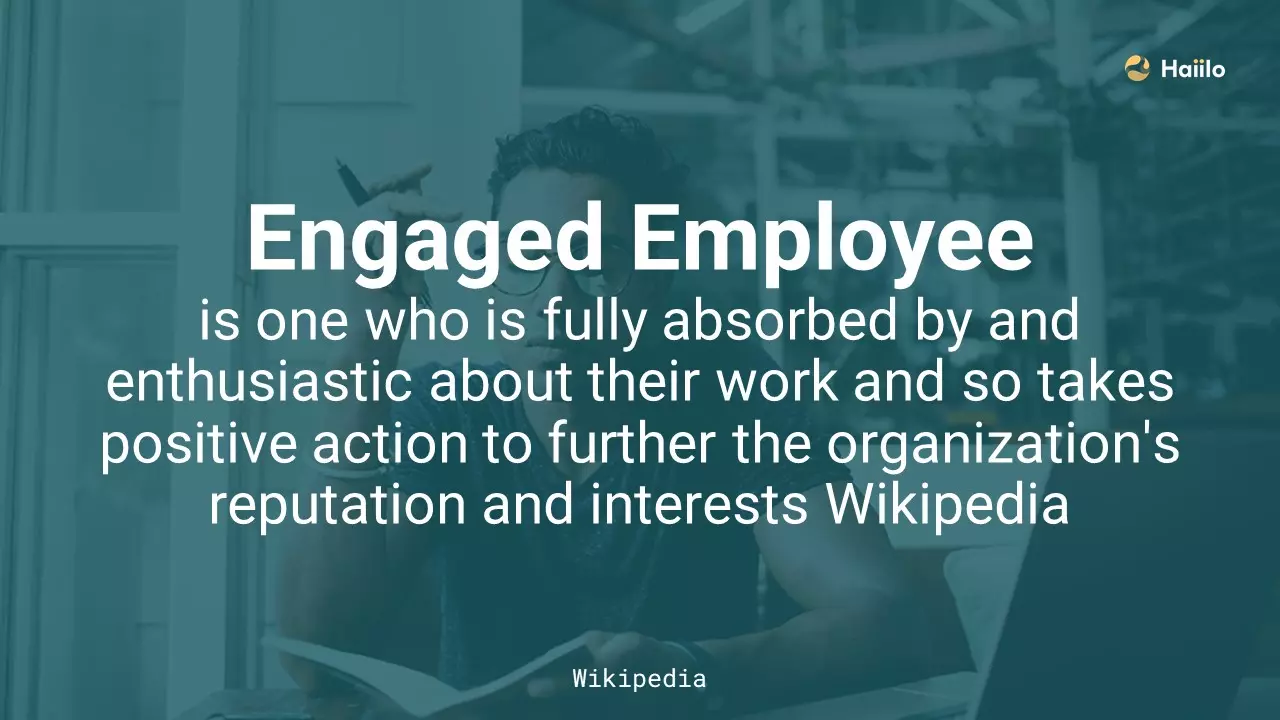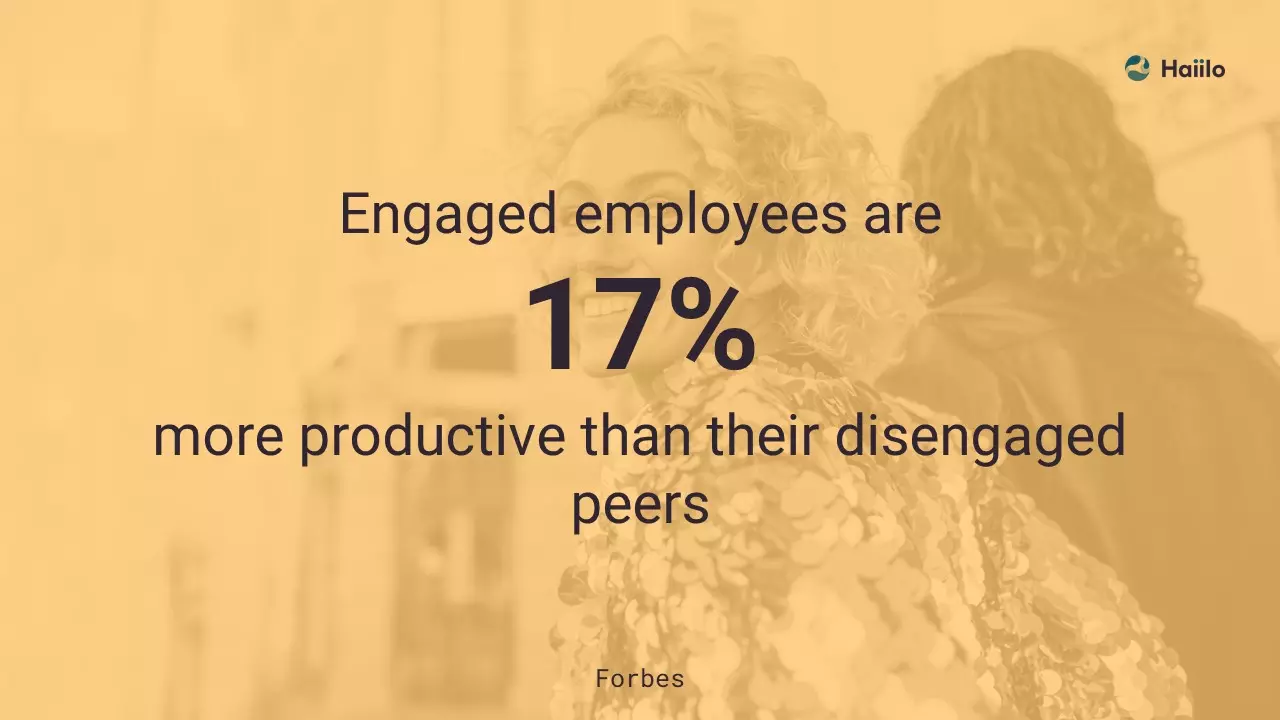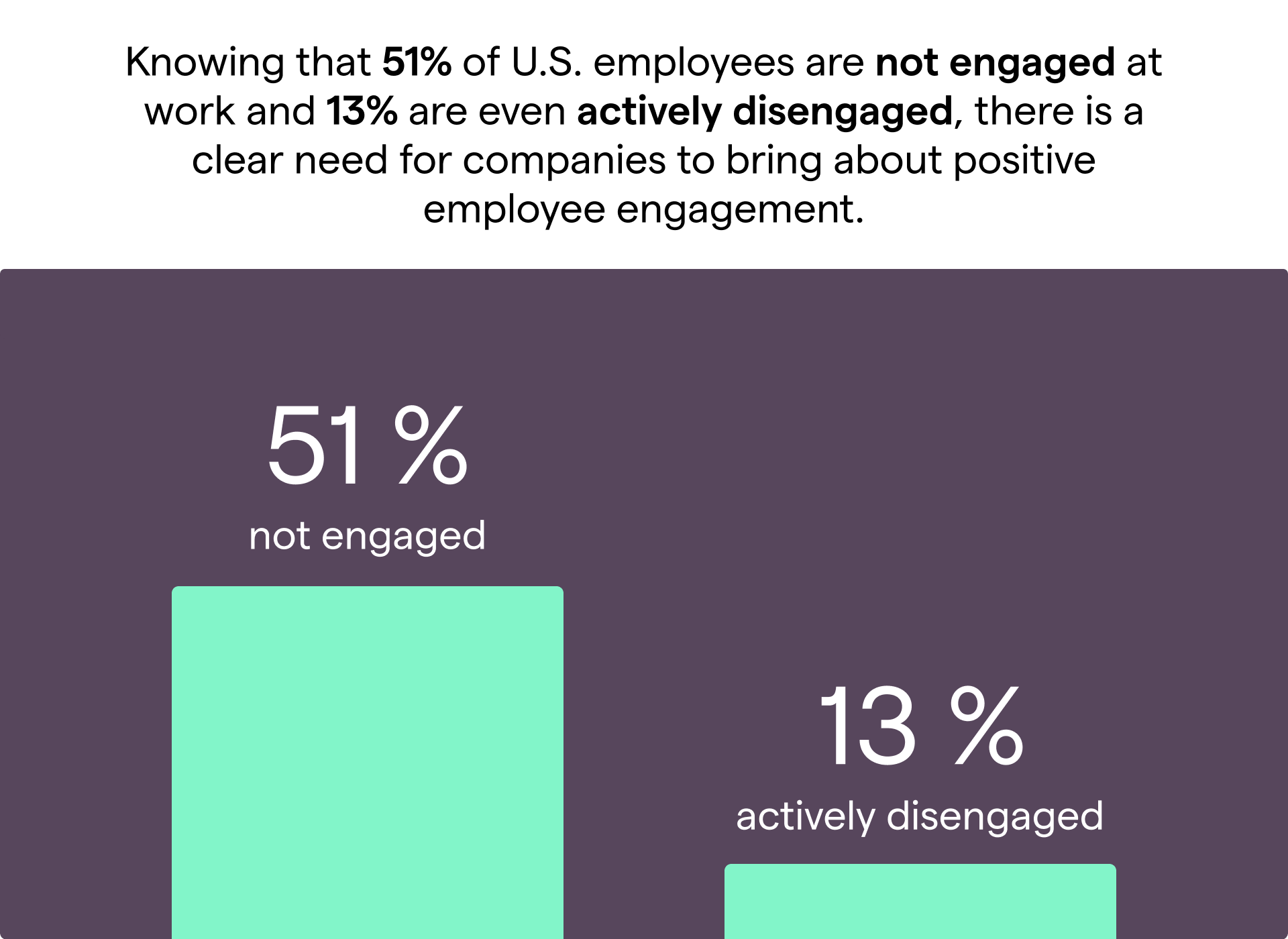Engaged employees make the biggest competitive advantage an organization can have. The level of employee engagement in a company directly impacts the company culture, employee productivity, well-being, and overall organizational success.
In this blog, we will define what being engaged means, identify the characteristics of engaged employees, and provide a guide for maximizing employee engagement in your organization.
📚Before we move forward, check out Employee Engagement: Definition, Current State, and Best Practices.
The Definition of an Engaged Employee
Employee engagement is a term introduced decades ago. Its definition has changed as employers started adopting new best practices and employee initiatives.
There is one universally accepted definition. According to Wikipedia, an engaged employee is
“one who is fully absorbed by and enthusiastic about their work and so takes positive action to further the organization’s reputation and interests. An engaged employee has a positive attitude towards the organization and its values.”

It must be said that this definition is pretty vague. It doesn’t really tell us about the characteristics of an engaged employee. It doesn’t give clear guidance on how to spot more engaged employees versus those who may be getting disengaged.
However, understanding the benefits and drivers of employee engagement is more important than having a single definition of engaged employees.
The best example is the hybrid type of work. Just a couple of years back, working remotely was considered a peculiarity of artistic and some rather introverted people. Today, many employees prefer flexibility over any other benefit an organization can offer.
📙 To ensure your company culture drives engagement, we have prepared for you the ultimate guide for building a positive workplace culture!
Now, let’s dive deeper into the characteristics of engaged employees.
Engaged Employees Appreciate and Drive Teamwork
According to research, 37% of workers see employee teamwork as very important. It is not surprising, therefore, that one of the most important characteristics of engaged employees is teamwork.

Employees who care about the greater good and don’t put themselves first are the biggest drivers of collaborative work in the workplace.
As cross-functional communication and collaboration are crucial for every company’s success, engaged employees can really make a difference. Furthermore, it is proven that individual engagement also drives team engagement.
Because engaged employees tend to possess good leadership skills, they are likely to influence others with their upbeat attitude, discipline, and work drive.
Engaged Employees Have a Positive Attitude Towards Work
Engaged employees show a positive attitude towards work. This is why they play a vital role in shaping a positive corporate culture. Their “nothing is impossible” attitude always drives them forward and helps them achieve good results.
Engaged employees are rarely jealous. They are sincere when celebrating others’ success. They understand the benefits of employee recognition and serve as role models for building a culture of appreciation and gratitude.
As a consequence, they often help their coworkers achieve better results. According to research, recognizing quality work and achievements of workgroups increases profits by 29%.
Engaged Employees Are More Innovative
Innovation is another sign of high employee engagement. If you realize that employees constantly come up with new ideas instead of focusing on obstacles, there is a high chance that their engagement levels are high.
There is plenty of academic research that proves this point.
Jyotsna Bhatnagar (2012) investigated connections between work engagement, psychological empowerment, turnover intention, and innovation. She found that innovation can be enhanced by cultivating a work climate that is genuinely engaging.
In 2015, Bailey, Madden, Alfes, and Fletcher reported their research into the meaning, antecedents, and outcomes of employee engagement for the International Journal of Management Reviews. Based on the results of 214 academic studies, a major discovery of their research was a strong link between engagement and innovative work behavior.
📙 Positive employee experience drives innovation at work. To ensure a positive employee experience in the workplace, check out our ultimate employee experience guide!
Engaged Employees Share Their Knowledge
One of the easiest ways to spot an engaged employee is by understanding to what extent they share their knowledge with other employees.
Knowledge sharing plays an important role in employee career development, growth, productivity, and innovation. And this is why knowledge transfer is considered one of the best traits among engaged employees.
Engaged knowledge workers are never selfish to help others and teach them how to solve problems best and eliminate challenges. Because they care about the greater good rather than their own, they will always do their best to help their team succeed.
Engaged Employees Are More Productive
Even though all the other characteristics of engaged employees are important, the ultimate goal every employer cares about is higher productivity and profitability.
Higher employee and company productivity, in fact, comes as a by-product of all the other traits that engaged employees possess.
Research shows that engaged employees are 17% more productive than their peers.

Consequently, highly engaged organizations have 21% higher profitability than their peers, while companies in the U.S. lose between $450-$550 billion each year due to disengaged workers.
Among some employees, productivity is pretty simple to measure. For example, if one employee in your customer support team has more successfully resolved tickets than another employee, this is probably a sign of higher employee engagement.
Engaged Employees Give More Feedback
Engaged employees like to receive constructive feedback, but they also tend to give more feedback. This is true for both peer-to-peer and bottom-up feedback.
Because bottom-up feedback is very important for leadership development, engaged employees are a perfect resource for helping managers in your organization grow and become better leaders.
Furthermore, peer feedback is important for boosting employee morale, enhancing teamwork, and driving employee growth and development.
It is important to remember that the emergence of hybrid work has brought some communication difficulties in the workplace, making it harder for employees to give and receive feedback. Thus, employers need to ensure that they provide the latest technology that enables seamless communication between and among teams.
📙 If you are looking for a workplace technology that drives employee engagement, check out our buyers’ guide for employee engagement apps!
Engaged Employees Are Good Communicators
In general, engaged employees have excellent communication skills. To provide clear feedback to others, they tend to be very good articulators, and they know how to clearly transfer an important message.
Being a good communicator also means being a good listener. Engaged employees like to listen to others, hear their concerns, and take other peers’ ideas into consideration.
They are empathetic and generally care about employee wellbeing.
COVID-19 has been the most stressful time for employees across the world, which is why many organizations have been introducing new employee well-being initiatives.
📙 Learn about employee well-being and how to implement a successful program.
Engaged Employees Have Low Turnover and Absenteeism
Attracting and keeping talent is one of the biggest struggles for employers across the world. Engaged employees tend to stay longer with their employers, which is considered one of the greatest benefits of high employee engagement. In the world of great resignation, organizations across the world are trying to figure out how to support their people better and keep them in the organizations.
Unlike unengaged employees, engaged employees rarely miss work. According to a Gallup Workplace report, businesses with engaged workforces have lower employee absenteeism rates by up to 41%.

If you notice an employee missing work regularly, this is one of the biggest signs of low engagement or even burnout. In that case, you should react immediately!
🎧 Employee turnover has been even bigger since the pandemic. If you work in a hybrid work environment, learn about its biggest challenges in our podcast!
More Interesting Facts About Engaged Employees
Let’s now take a look into some other interesting facts about engaged employees:
- In its State of the Global Workplace report, Gallup concludes that “20% of employees are engaged at work.
- Gallup presents that since it started reporting employee engagement, the highest percentage of engaged employees recorded in the US was 36% in 2021.
- From data collected from a random sample of 4,700 employees in the US, Gallup recorded the lowest percentage of actively disengaged employees in 2019, at 13%.
- 38% of remote employees reported feeling exhausted after daily virtual meetings, while 30% said they felt stressed.
- According to Trade Press Services, effective internal communications motivate 85% of employees to become more engaged in the workplace.
- According to a recent Gartner poll, only 16% of companies leverage technology to track employee progress and engagement.

- One study on top performance motivators found that 37% of employees feel most encouraged by personal recognition.
- Not surprisingly, only 25% of actively disengaged employees were recognized for a job well done.
- According to a Korn Ferry survey, 33% of employees jump ship because they feel bored in the workplace and want to find new challenges.
- The Harvard Business Review Analytic Services surveyed more than 500 business executives, and “71% of the respondents [ranked] employee engagement as very important to achieving overall business success.”
- “highly engaged business units achieve 59% less turnover” in high turnover organizations and “24% less turnover” in low turnover organizations.
- Karlyn Borysenko suggests that a disengaged employee costs the company about 34% of their salary.
How To Keep Employees Engaged?
Every organization is different, and there is no universal way that ensures high employee engagement. The most important thing is to understand your employees and employee experience factors that drive higher engagement.
While some employees may be motivated solely or mostly by compensation and benefits, others may care more about opportunities for growth and development. Others may care about intrinsic motivators such as frequent acts of recognition and appreciation.
Here are some of the most common employee engagement drivers:
- Compensation and benefits
- Alignment with organizational mission and vision
- Good leadership and relationship with managers
- Career development opportunities
- Interesting projects, digital workplace, and the use of the latest technology
- Frequent feedback and recognition
📙 To learn more about improving employee engagement in the workplace using each driver, check out our detailed employee engagement guide.
If you are looking for an employee engagement platform for your organization, schedule a Haiilo demo today to learn how other organizations have improved the workplace experience and employee engagement with it!










